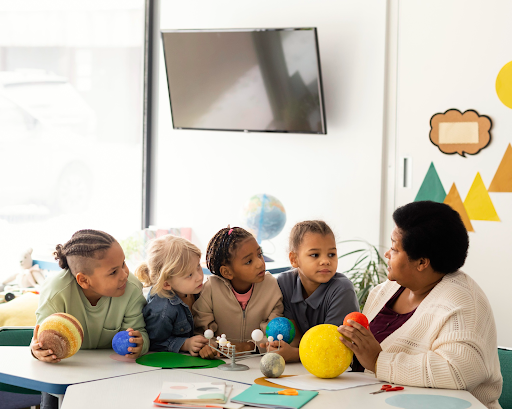If your child isn’t using words to express themselves, it can feel like a wall is between you, making everyday moments harder than they should be. But here’s something important to remember: your child can communicate, even if words are not part of the picture.
Augmentative and Alternative Communication (AAC) is a great tool that allows kids to put out what they are thinking in a way that works best for them, whether that be through the use of pictures, symbols, or technology. Also, when we add in Applied Behavior Analysis (ABA), which is a therapy that focuses on introducing new skills and positive behaviors, AAC can really transform how your child engages with the world.
In our blog post, we will look at how AAC and ABA therapy team up to help your child find their voice, often without the use of words. It is a challenge but with the right support, your child may learn to put out the things they want to say in a way that works for them.
AAC: A Path to Communication
Augmentative and Alternative Communication (AAC) is a wide term that includes everything a child may use in place of speech, from picture cards to electronic devices that produce speech. These tools serve to fill in the gaps when words do not suffice.
Additionally, they are very effective as they give children the means to put forth their wants, needs, and feelings in what is true for them.
Your next question might be what this has to do with ABA training. The way it breaks down big, hard skills into small, doable steps opens up new opportunities, like in conversation. When AAC is used along with ABA treatment, it opens up a lot of possibilities for kids who need extra help.
Think of your child having the ability to tell you that they are hungry, to express excitement about a favorite activity, or to let you know they need a break. It may not look like a regular interaction, but it is communication. Also, with ABA’s help, we can get children with autism to use AAC tools to put out what they are thinking in a way that is meaningful to them.
How ABA and AAC Work Together
The difference between the two is that one is a set of tools for communicating, while the other is a way to teach habits and skills. It is important to know, though, that AAC and ABA work great together, like two puzzle pieces that fit together perfectly. This helps kids interact in very useful ways.
ABA is into breaking down skills into small doable steps and we see great results with this approach in the field of AAC. For instance, an ABA behavior analyst may begin by getting a child to use a picture exchange to request what they want, like food or a toy. Each time the child does this successfully, the therapist reinforces the behavior, which causes the child to repeat that action in the future.

ABA magic takes place when we apply techniques such as reinforcement, prompting, and shaping to AAC. In this technique, an ABA therapist works with a child to practice the use of their AAC devices in many settings, which ensures that the child learns how to use the tool and begins to see its value in real-life situations.
It is not just about getting a child to press a button or point to a picture; it is about how we help them to see that this tool is a means to connect with others, to put into words what they need, and to interact with the world in an empowering way.
In every case of autism, what we see is a unique set of issues from child to child, which is what ABA services are best for. Each child comes to the table with their own set of needs and what is special about ABA therapy is that it is very much a tailor-made solution.
Thus, it may be a picture exchange system, a speech-generating device, or sign language, but the therapist will work with the child to develop the best approach for that particular child.
How AAC and ABA Therapy Can Transform Communication
Each child with autism is different, and so is how they communicate. Some kids may have trouble with words, which is ok; they still have many ways to get their point across. With the right tools and support, kids with autism can communicate as well as their peers. That is what Augmentative and Alternative Communication (AAC) and Applied Behavior Analysis (ABA) do.
ABA therapy is a staged approach to learning, which we present to the child in very doable steps, which makes the process of acquiring new skills a less daunting task for the child.
In some cases, a child may begin with a picture card, which they use to request things like a snack or a toy. The therapist at this stage will praise each time the child successfully uses the card, which in turn helps the child to realize that the use of AAC tools is a good way to communicate.
As time goes by, ABA therapy introduces what may be speech-generating devices or sign language, which are based on the child’s individual needs and which grow with the child.
- ABA therapy is personalized: ABA therapy’s strength is in its personalized approach. Therapists adapt their methods to each child’s unique way of communicating and what works best for them, which in turn gives them the best set of tools for expression.
- Consistency across environments: ABA sees to it that AAC devices are used the same way in all settings, at home, in a center-based ABA setting, and with friends, which makes children confident to use them in any situation.
- Long-term skill development: ABA therapy develops long-term communication skills, which we see progress from very basic picture exchange systems to more complex devices as required, helping kids to grow and communicate more by themselves over time.
- Confidence and independence: The combination of AAC with ABA therapy goes beyond the scope of communication; it is a tool to help children build up their confidence and their connection to the world.

Supportive ABA Services by Willow Reach ABA
At Willow Reach ABA, we are focused on providing tailored and compassionate therapy that puts in place what it takes for children to do well. How we do that is:
- In-home therapy: Willow Reach ABA provides in-home ABA therapy, which we find to be a very familiar setting for your child, reducing stress and helping them learn better in an environment that is most comfortable for them.
- Center-based therapy: In a more structured environment, which does best for some of our children, we provide a safe and supportive setting in which they may practice social and communication skills under the hands of expert staff.
- Experienced ABA therapists: Our team consists of ABA therapists, whom we have trained well to use individualized strategies, supporting each child’s unique needs. We also put in place the right communication tools, including AAC.
- Family collaboration: At Willow Reach ABA, we work with families to support the implementation of therapy, helping align treatment goals to the child’s needs and report on progress in day-to-day life.
- Supportive, fun environment: In both home and center-based settings, we have designed therapy to be a fun and engaging experience, helping children feel secure and confident as they acquire new communication skills.
Willow Reach ABA’s strategy is to provide the right support for your child at all times.
Conclusion
As a parent, what you seek is helping your child find their voice, whether that be through words, pictures, or devices, which is an extremely rewarding experience. We see great value in the use of AAC and ABA therapies, which put in place a bridge to meaningful communication, helping children with autism connect with family and the world in their very own special way.
With the help of dedicated ABA therapists and AAC tools, kids not only learn how to talk to others, but they also gain the confidence to make friends, talk about their feelings, and take part in everyday life in a meaningful way. It is a process of patience, consistency, and care, which we see play out in very small steps that are still very much victories.
If for you, the issue at hand is finding a team that is well-versed in the support of your child’s communication growth, come to Willow Reach ABA. We offer the right mix of professional ABA services and also very personal care, which guarantees that your child’s communication needs are met in a very supportive setting.
No matter what stage your child is at in their development of communication skills, what we should know as parents is that all voices count, and with the appropriate support, your child may acquire a method of communication that is what they need.
Frequently Asked Questions About AAC and ABA Therapy (FAQs)
- What is the role of an ABA therapist in helping my child communicate without words?
ABA therapists break down communication skills into doable steps, use reinforcement to encourage progress and see to it that your child can communicate in many settings, such as at home, in school, and in social situations.
- How can ABA training programs benefit therapists working with children using AAC?
ABA training programs give therapists the tools to assess and develop individual communication plans for each child. Also, they learn to adapt ABA methods to support kids who use AAC, which makes the therapy very personalized to each child’s needs.
- What are some ABA techniques commonly used with children who rely on AAC?
Some common ABA approaches used for AAC are reinforcement (which may include praise for communication attempts) and prompting (which guides the child in the use of the AAC system). Also, we see shaping, which is a method of gradually increasing the complexity of communication. These techniques help kids to use the AAC devices regularly and appropriately.
- What makes Willow Reach ABA different from other providers of ABA services?
Willow Reach ABA tailors their services to the needs of each family. We provide a range of treatment options, from in-home-based therapy to that which takes place in a center. Also, we have a very experienced team that works very closely with the families to create a very comfortable and supportive environment, which is very beneficial for the child’s growth and learning.
- How can I get started with ABA services at Willow Reach ABA for my child?
At Willow Reach ABA, we have made it easy for you to get in touch. You may call us or visit our website. Our team will talk to you about your child’s needs, answer all your questions, and walk you through the process of arranging that first meeting.
